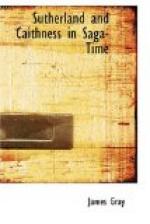[Footnote 30: See Tudor, O. and S., p. 344.]
[Footnote 31: O.S., 101. Who this Erlend the Young was is unknown, but he can hardly have been Jarl Erlend Haraldson, Margret’s nephew. Dasent, Rolls Edit., trans., p. xi. Tudor, O. and S., p. 445.]
[Footnote 32: O.S., 102. Ingigerd would thus be born not later than 1136. She is possibly the “Ingigerthr, of women the most beautiful” in the Runes of Maeshowe.]
[Footnote 33: O.S., 102, not “from Beruvik,” but “from the bridal” (brudkaupi) probably.]
[Footnote 34: This may be another headland. Brimsness is suggested. O.P., ii, 801, contra.]
[Footnote 35: O.S., 103, 104.]
[Footnote 36: O.S., 105. See as to Ellar-holm (Helliar-holm) Tudor, O. and S., 283.]
[Footnote 37: O.S., 110, 111.]
[Footnote 38: O.S., 111.]
[Footnote 39: Curle, Early Mon. Suthd., p. 108 No. 316; and note that the horns of the elk or reindeer have been found in Sutherland. See Proceedings of Scot. Antiq., viii, p. 186; and ix, p. 324.]
[Footnote 40: Thorsdale is the valley of the Thurso River. Calfdale is the Calder Valley.]
[Footnote 41: Force; possibly Forsie, or some waterfall said to be near Achavarn on Loch Calder at the S.E. end of it. Halvard is in the Flatey Book called Hoskuld. O.P., ii, 761, at a ruin of a castle, Tulloch-hoogie.]
[Footnote 42: O.S., 112, 113. “Ergin” is the plural of airidh, airidhean or “sheilings.”]
[Footnote 43: Torfaeus. Lib. 1, c. 36, sub. fin., with Papal authority (sed quaere).]
[Footnote 44: Ingibiorg or Elin possibly married Gilchrist, Earl of Angus, as his second wife. But as to this the Sagas are silent.]
[Footnote 45: O.S., 113. See O.S., Dasent trans., p. 225. Hakon Saga, 169, Rolls edition.]
CHAPTER VII.
[Footnote 1: O.S., 114. There is a Mac William Earl of Caithness on record in 1129. Seats Peerage (Paul).]
[Footnote 2: O.S., 81. O.S., Dasent trans., p. 225.]
[Footnote 3: O.S., 115-118.]
[Footnote 4: Torf. Orc., p. 153. He declined to come and fetch her.]
[Footnote 5: O.S. Addenda, p. 225. Rolls edition, trans.]
[Footnote 6: Sverri Saga, 90-93.]
[Footnote 7: Scottish Peerage, vol. viii, p. 318 sqq.]
[Footnote 8: Quoted by Nisbet, Heraldry, App. p. 183, and Dalrymple’s Collections, 1705, pp. 66-7 “quas terras pater suus Friskin tenuit tempore regis David.” Felix, Bishop of Moray, who is a witness to it, was appointed in 1162 and died not later than 1171. As to David’s visit to Duffus, see Chron. Mailros, 74.]




